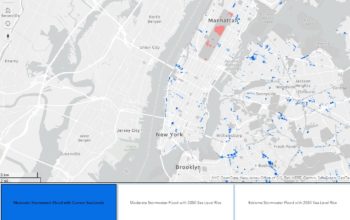
The interactive storm water flood map can show New Yorkers what areas are susceptible to flooding during severe rainfall. Image credit: NYC OpenData.
On July 7, 2022, NYC Mayor Eric Adams, along with New York City Department of Environmental Protection Commissioner Rohit T. Aggarwala, and New York City Emergency Management Commissioner Zach Iscol, released the Rainfall Ready NYC action plan. This plan was designed to prepare the City’s government and residents for future extreme rainfall, given current climate changes.
“Climate change is the city’s biggest environmental threat, and while we continue to invest in resiliency and infrastructure projects to protect us for generations to come, the Rainfall Ready NYC action plan will help every New Yorker to protect themselves, their families, and their homes,” stated Mayor Adams.
NYC has over 7,500 miles of sewers capable of capturing rainfall from a five-year storm. Additional short-term infrastructure projects will be implemented to mitigate flooding. The Department of Design and Construction (DCC) and the Department of Environmental Protection (DEP) will work together to complete three high level storm sewer projects, six traditional sewer projects, and install 1,300 more green infrastructure assets by June 2023.
New York City Chief Climate Officer and DEP Commissioner Aggarwala stated, “The design and construction of large infrastructure projects to manage our changing climate will take time to complete and Rainfall Ready NYC is meant to outline the shared actions that can be taken in the short-term to ensure public safety.”
New Yorkers can access various tools to become aware of impending rainstorms and consequent flooding as well as to protect their homes, families, and property from flooding. The Department of Environmental Protection created an interactive map which users can navigate to determine whether their homes are in flood-prone areas. The City has also expanded FloodHelpNY, a website that provides information and resources about flood risk, insurance, and retrofits. Signs will also be installed in chronically flooded locations to ensure that passersby and motorists are aware of flooding dangers related to those locations.
In the face of stormy weather, New Yorkers are recommended to set up sandbags and deployable barriers, stock up on food, water, medicine and batteries, elevate or remove belongings in basements, clear debris near curb lines, sign up for and listen out for NYC alerts, buy flooding insurance, and take care of any construction issues that may lead to rainwater entering their property such as cracks and poorly fitted doors and windows.
NYCEM Commissioner Iscol stated, “With hurricane season and summer under way, I also encourage New Yorkers to make emergency plans that best match their needs before extreme weather and other emergencies occur, by visiting us online or calling 311.”
NYC delivery workers will be made aware of flooding dangers and precautions to be taken in stormy weather. Different protocols will be developed to ensure the safety of delivery workers by a City-engaged working group consisting of Los Deliveristas, Uber Eats, GrubHub, and DoorDash.
Sascha Owen, senior manager of government relations, DoorDash stated, “The safety of delivery workers and the communities we serve is core to everything that we do, and we will continue to work closely with policymakers and share the lessons we’ve learned from developing our robust emergency response protocols.”
By: Malka Amar (Malka is a CityLaw intern and New York Law School student, Class of 2023.)
Mayor: “Mayor Adams Releases Rainfall Ready NYC Action Plan, Preparing City Government and New Yorkers for More Extreme Rainfall” (July 7, 2022.)


“Different protocols will be developed to ensure the safety of delivery workers by a City-engaged working group consisting of Los Deliveristas, Uber Eats, GrubHub, and DoorDash” is neoliberal code for NYC will use its federal bucks to subsidize extractive business instead of moving basement dwellers to safer apartments.